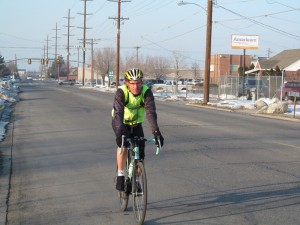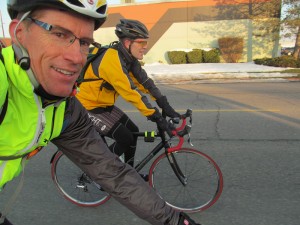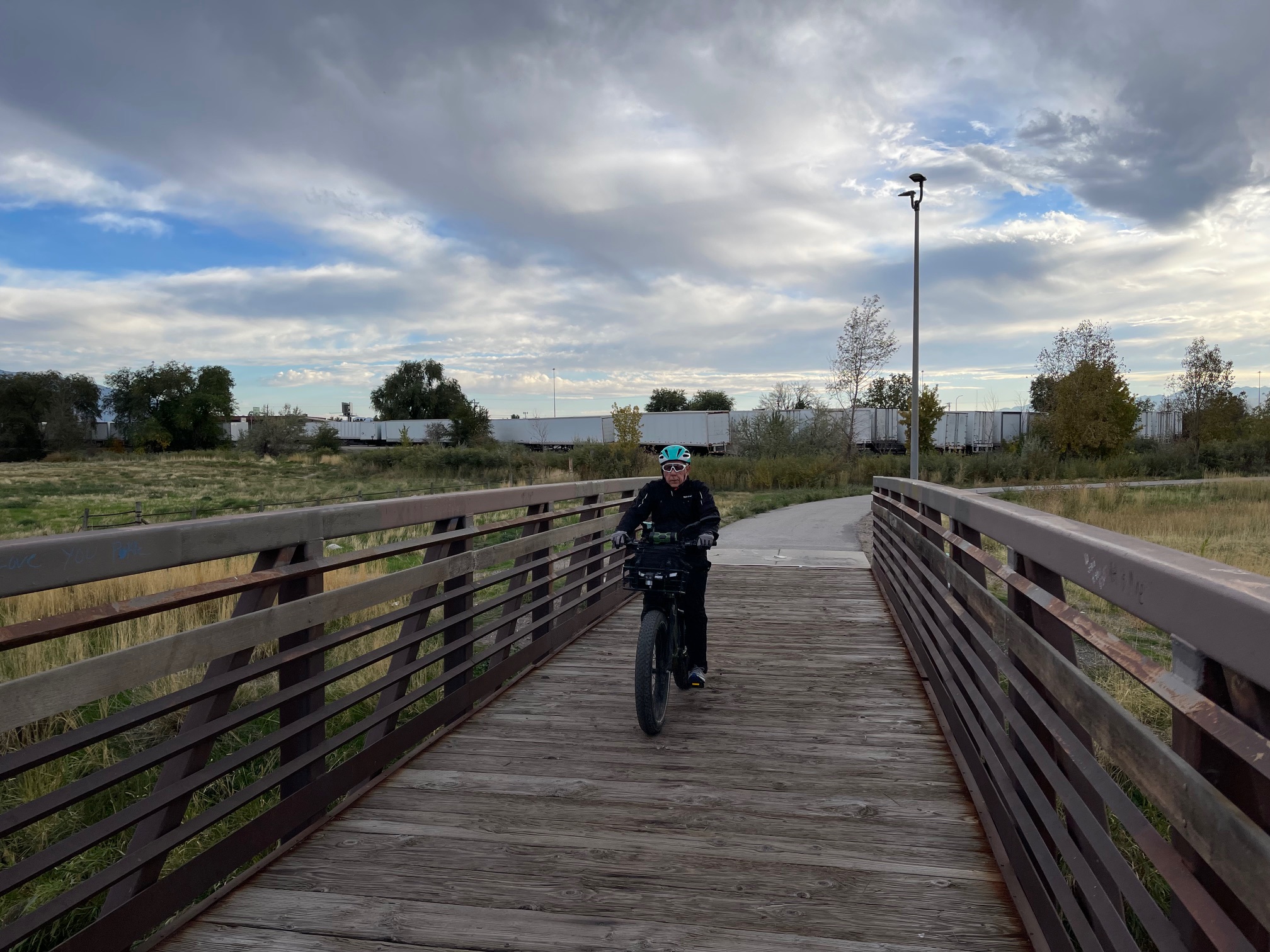
By Lou Melini
Trent Duncan has spent an envious amount of time on his bicycle. He is a dedicated bike commuter, occasional racer and bike traveler, in addition to being a family man spending time with his 4 adolescents and wife. Trent is a 45 year-old mechanical engineer working for the Bureau of Land Management (BLM).
Cycling Utah: When did you obtain your first bike and start “commuting” on it?
Trent Duncan: For my 8th birthday my dad took me to Highland Schwinn where we purchased a Schwinn Stingray bike with 20” wheels, a red, banana seat and 5-speed thumb shifter. My dad dropped me off a few blocks from home and I rode from there. I vividly recall that the shop sent the bicycle home with under inflated tires and it was a real pain to pedal the bicycle. I rode this bicycle the half-mile to Hillview Elementary from 2nd or 3rd grade on. To secure the bicycle at school, my dad bolted a chain around the head tube of my bicycle. The chain then wrapped around my seat post and a lock held the end to the chain to the bolted chain on the headtube. The whole thing rattled as I bounced down the street. It did not take me long to figure out a different lock assembly. I cycled all through elementary and then to junior high.
C.U.: What came next?
T.D.: My first “real” bicycle was at age 15. I purchased a Miyata 310 from Bicycle Center. I think it was about $300. I also purchased a Bell Helmet from Fishers Cyclery for about $40. I rode everywhere including my year-round work at the elementary school, to my grandpa in Murray to mow his lawn, or to my cousin’s in West Valley to work on go-carts and other “projects”.
At 16 I was working and riding with a friend who just graduated from Olympus High School. She and a couple other friends thought it would be fun to ride to Yellowstone National Park and were willing to work out the logistics. We arrived the first night in Logan after dark in the rain and stayed with a cousin of one of the girls. On day two, we rode to Idaho Falls, ID. I remember getting buffeted by the trucks along I-15 near Pocatello and riding off the shoulder into the ditch by accident. Jolene’s dad (Joe Fisher) drove a small truck with our gear the first two days before returning home. After that we each took turns driving the small truck and riding. Day 3 we rode into West Yellowstone, MT over some pretty big climbs. All together we rode for 7 days. I joined my parents at Pineview Reservoir on the last day after riding over Monte Cristo pass.
C.U.: After high school you went on a mission, but for you it was an extraordinary mission.

T.D.: I always wanted to live and commute with only a bicycle. The dream came true with a mission call to the Netherlands Amsterdam Mission for the Church of Jesus Christ of Latter Day Saints. Serving a mission was a great experience in so many ways. I spent 22 months riding a bicycle in Holland and Belgium. The bikes all had fenders, panniers and big seats. We cycled doing our missionary work. Additionally we hauled groceries, toured castles and traveled the countryside on our bikes. The whole experience is captured gracefully in the movie “The Best Two Years”. One winter was cold enough to freeze all the canals. We bicycled on the ice with all the folks out ice-skating.
C.U.: Cycle commuting then took you to the University of Utah and your current job.
T.D.: I rode to the U of U for 4 years during school prior to my current employment. I have worked for the BLM for over 22 years. I live in South Jordan and cycle year-round to my office in downtown Salt Lake City at the Gateway. I have been cycling the 36 miles round trip from South Jordan for 18 of those years. We have a small locker room and a shower at work. I keep pants and a belt at work to minimize what I carry in the backpack or pannier. I feel like Mr. Rogers every morning putting on one of three pair of shoes once I get to my desk. The Gateway constructed a bike storage room for our agency. We have bike racks, a pump and sometimes 12 bicycles parked inside. On these cold winter mornings, I find myself camping out under the hot shower for a long time trying to recover. On days that are too sloppy, or I need to get home early, I hop on the TRAX train which puts me 2 miles from home. One friend who now lives in Millcreek has been a commuting companion for that entire time. Other commuting companions come and go as seasons and jobs change.
C.U.: A 36-mile round trip commute is quite a ride. How do you get from South Jordan to the Gateway?
T.D.: The “standard” route is 2700 West, Sugar Factory Road, 2200 West, 7000 South, Jordan River Parkway (JRP), 4800 South, 300 West, Central Ave, West Temple, 1200 South, 200 West, 200 South to the office. Variations include every other road in the valley. I love West Temple with the canopy of trees in the summer and the sound of crunchy leaves under the tires in the fall. I love the south wind in the mornings and the north wind in the afternoon. I really enjoy all that the JRP has to offer, no matter what the season. A lot of people are out walking, riding or doing other activities along the JRP. I watch the Jordan River and Cottonwood creeks as they rise and fall during the seasons and enjoy how they respond to the changing runoff patterns. The vegetation along the trail blossoms in the spring, yellows during the summer turning golden in the fall. I feel more connected to nature along the trail than while riding the more sterile industrial streets. I believe the JRP is a huge asset to the community as are similar trails. There are so many ways that the trail gets used from Cub Scout nature hikes to commuters like me.
Goat heads can be a problem along the JRP, but the section I ride regularly (4800 – 7000 South) sees enough bicycle and foot traffic that they are not an issue. Snow & ice are a bit of a problem and I avoid the trail in the colder part of the winter. Alternate routes are really good and the JRT is easy to avoid by taking 3200 West, 2700 West, 700 West, 1300 West, 300 West, & 900/700 East (south of 5900 South). Even State Street in the morning is kind of fun to ride. I really have great routes to choose from. This makes the riding much more fun and I feel generally safe on the wide shoulders. I try to pick routes with posted speeds of 35-mph or less.
C.U.: Over the time that you have been commuting, how has the cycling environment evolved? How has TRAX influenced your commute?
T.D.: In general, the road conditions come and go with the maintenance of the roads. I am always making adjustments, but overall, the conditions and shoulders/ bike lanes have greatly improved in every city in the county.
The worst part of my route is getting east to west between Redwood Road and 1300 West. I typically ride east/west on 7000 South. It has no shoulder. There is not even room for a white line. The traffic is “gutter to gutter”. In the mornings, I let the eastbound slug of cars race by, then I take my own lane. It is down hill so I can ride at 25-28 mph and about match the traffic speed. In the afternoon, the traffic is frequently backed up from Redwood Road, but every couple weeks I have a car and mirror just inches from my shoulder. I have tried alternates, but 6400 South has been ruined for westbound bicycles with the Redwood Road intersection. 7800 South has horrible shoulders and fast traffic, 9000 South has fast traffic and lots of cars turning in and of businesses. 9800 South is the next best option but it is further south than my home.
Cycling gives me flexibility to meet my wife or kids after work at soccer games, grandparents, dance performances, family cabin in Oakley, or other places without having to take an extra car. I set out some clothes and shoes for my wife to bring and I can do a quick change at the event.
I would say that TRAX allows me to cycle more. I take the train 2 or 3 times a month to get home quicker, or for other reasons. I love the flexibility of being able to just “hop on” the train and get home. The TRAX is 15 minutes faster than cycling and only 15 minutes slower than driving. I guess my cell phone and transit pass are the two most valuable tools I carry.
C.U.: You have a nice situation at work for commuting. How did that happen?
T.D.: Our first building had a nice restroom with a shower. I am not sure how it came to be, but I was very grateful to have it. We also installed a bike rack inside our break room. This gave us a secure safe place to store the bicycles. In 2005 we moved to the Gateway. The building was required to be a LEED rated building under the USGBC building rating system. The building owner (Boyer) was encouraged by the architect (GSBS) to install a shower and changing facilities that contributed towards the LEED rating effort. We have 12 small lockers and a shower that get used by the BLM employees. The Boyer Company also installed a bike closet in the parking garage where we can secure bicycles out of the weather and away from the parking lot thieves.
C.U.: What do you use for commuting and what are some of your essential accessories?
T.D.: My preferred commuter is a Surly Pacer (’06) rebuilt a year ago with Campagnolo Veloce 10 speed and Fulcrum Racing 7 cyclocross wheels with Continental 4000 tires. There is plenty of room for fenders with this frame. My saddle is a Brooks B17. I use a rear rack for a single pannier in the summer and an REI flash pack in the winter to keep my back warm. The bicycle is heavy but handles well. I keep a tube and a frame pump on the bike. I prefer a frame pump to CO2 cartridge because I know I can get the tire up to 120 psi (with 120 pump strokes). ). My winter commuter is a Bianchi Axis built with the parts I had laying around the garage. I put fenders on it and it can plow through most of the slush and snow without soaking me. I also carry a cell phone and am not afraid to call in “aerial support.”
Some of my other required equipment includes: An indoor/outdoor wireless thermometer kept near the sink of my bathroom. The first thing (well, actually the second thing) I do after I wake up is to check the outside temperature. I base my clothing selection on the temperature and put on more clothes as the temperatures drop. I think 27 articles of clothes, including helmet and shoes, is my record number of clothing items. My favorite items of clothing include Smartwool arm warmers, a cycling vest, and DeFeet wool knee warmers.
Lighting and safety are becoming more important to me and I am trying to be more visible with colors and reflectors without losing too many “style points”. I use a 200-lumen Light and Motion headlight. This one has a big battery and I can get about 5 hours on high. I also have a couple of blinking taillights, a bright green vest and reflectors on my pannier and backpack.
C.U.: What are some of the other activities that you do on a bike?
My wife and I try to do a 3-day bicycle tour every couple years in September for our anniversary. I carry all the gear with front and rear panniers. She gets to ride and smile. These trips have included: Park City to Pine View, Ogden and Front Runner back home. Saratoga Springs to Nephi, then Manti and back home (in the car) with friends. This fall we rode from Salt Lake to Brigham City and toured the new Brigham City Temple. Front Runner brought us back to SLC. In addition, my son likes to mountain bike. We had a blast on the trails in Draper this fall.
My first “race” was the Salt City Classic. It was 4 hours of riding around Murray Park. I think I rode over 75 miles. My bike commute became easier after I started riding with the MiDoule cycling team where I learned paceline riding, some tactics, and how to suffer. I have raced in the Snowbird Hill climb, LOTOJA, East Canyon Road Race, High Uintas Classic, Utah Summer Games, Eureka Road race, Porcupine Hill climb, Mt. Evans Hill Climb, Utah Cyclocross series, and others. The commuting is great way to get base miles and has allowed me to enjoy some racing over the past 12 years. I try to do a few races each year as time allows.
My favorite race of 2012 was the Crusher in the Tusher. Training for this race was a total blast. My training buddies found new CX routes we would never have ridden on a road bicycle. We rode Butterfield Canyon to the Kennecott mine overlook then down to Tooele and back. We also rode Big Cottonwood, Guardsman, Deer Valley, Wasatch Mountain State Park, Guardsman, and back down Big Cottonwood Canyon.
Some teammates put together a tour titled “Tour de South” a few years ago. The route started at Fish Lake and rode down to highway 89 to Panguich and up to Brian Head for the first night. The next day we rode back to Panguich and along Highway 12 to Escalante for the second night. The third day we continued over Boulder Mountain to Torrey and then back up to Fish Lake. 333 miles in three days with great scenery, lots of climbing and a group of strong well matched riders. I had cycled many segments of the route but really enjoyed linking the route together with someone else figuring out all the logistics with the lodging and baggage.
I frequently take my bicycle on work trips and take off in the evenings or mornings on the quiet Utah highways around Moab, Bluff, Blanding, Escalante, Kanab, St. George and Fillmore. I took my CX bike to Alaska last summer and rode on the Dalton highway 347 miles north of Fairbanks after work a couple evenings. My wife looks back and recognizes she should have suspected something when we rented bicycles on our honeymoon in Lake Tahoe. I am still cycling and loving it!
C.U.: Trent, this has been fun and informative. Thank you for participating.
If you have a suggestion for a commuter profile, have a commuter question, or other comments, please send it to lou@cyclingwest.com.








